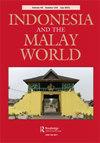IF 0.9
3区 社会学
0 ASIAN STUDIES
引用次数: 2
摘要
摘要1511年马六甲沦陷于葡萄牙人之后,亚齐开始成为一个强大的马来苏丹国。1524年,亚齐吞并帕赛及其邻近的政体后,逐渐取代马六甲成为马来世界的中心。亚齐苏丹国举行了精心策划的仪式和庆祝活动,其中包括在街头游行中播放音乐,作为其王室习俗的一部分。这被视为统治者不仅对其人民和其他地区苏丹国,而且对外国游客的权威和存在的重要视觉和听觉表现。贵族是一个宫廷音乐合奏团,是马来皇家机构的核心,因其神秘的力量以及巩固和维护社会政治秩序的能力而备受尊敬。在17世纪的一本名为《亚齐风俗》(Adat Aceh)的文本中记录了在亚齐宫廷仪式中使用贵族和其他乐器的情况。这篇文章探讨了文本及其音乐内容,并得到了欧洲文献的支持,以分析音乐在亚齐宫廷的宗教仪式和宗教仪式中的重要作用。本文章由计算机程序翻译,如有差异,请以英文原文为准。
The Adat Aceh
ABSTRACT After the fall of Melaka to the Portuguese in 1511, Aceh began to assert itself as a formidable Malay sultanate. After annexing Pasai and its neighbouring polities in 1524, Aceh gradually replaced Melaka as the centre of the Malay world. The Aceh sultanate held elaborate ceremonies and celebrations, which involved the playing of music in street processions as part of its royal adat or customs. This was seen as an important visual and aural representation of the ruler’s authority and presence towards not only its people and other regional sultanates, but also foreign visitors. The nobat, a court musical ensemble, was central to a Malay royal institution, revered for its mystical powers and ability to consolidate and maintain socio-political order. The use of the nobat and other instruments in the Acehnese court ceremonies was documented in a 17th-century text called the Adat Aceh (Customs of Aceh). This article looks into the text and its musical content, supported by European accounts, in analysing the important role of music in the adat and istiadat of the Acehnese court.
求助全文
通过发布文献求助,成功后即可免费获取论文全文。
去求助
来源期刊

Indonesia and the Malay World
ASIAN STUDIES-
CiteScore
2.00
自引率
0.00%
发文量
17
期刊介绍:
Indonesia and the Malay World is a peer-reviewed journal that is committed to the publication of scholarship in the arts and humanities on maritime Southeast Asia. It particularly focuses on the study of the languages, literatures, art, archaeology, history, religion, anthropology, performing arts, cinema and tourism of the region. In addition to welcoming individual articles, it also publishes special issues focusing on a particular theme or region. The journal is published three times a year, in March, July, and November.
 求助内容:
求助内容: 应助结果提醒方式:
应助结果提醒方式:


